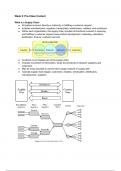Class notes
Supply Chain Logistics Weekly Notes
- Course
- OPER73020
This document contains the weekly class notes for the supply chain logistics course. In this course, you will investigate many examples of the classic cost/service trade-off that is the major challenge for all supply chain managers. The major emphasis of the course is on the utilization of stra...
[Show more]



